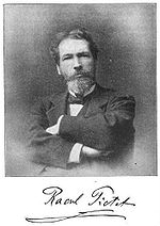
Raoul Pictet
Encyclopedia
Raoul-Pierre Pictet was a Swiss physicist
and the first person to liquefy nitrogen
. He was born in Geneva
and served as professor
in the university of that city. He devoted himself largely to problems involving the production of low temperatures and the liquefaction and solidification of gases.
On December 22, 1877, the Academy of Sciences in Paris
received a telegram from Pictet in Geneva reading as follows: Oxygen liquefied to-day under 320 atmospheres and 140 degrees of cold by combined use of sulfurous and carbonic acid. This announcement was almost simultaneous with that of Cailletet
who had liquefied oxygen by a completely different process.
Pictet is the author of Mémoire sur la liquéfaction de l'oxygène, la liquéfaction et la solidifaction de l'hydrogène et sur les théories des changements des corps (1878); Synthèse de la chaleur (1879); Nouvelles machines frigorifiques basées sur l'emploi de phénomènen physicochimiques (1895); Etude critique du matérialisme et du spiritualisme par la physique expérimentale (1896); L'Acétylène (1896); Le carbide (1896); Zur mechanischen Theorie der Explosivstoffe (1902); Die Theorie der Apparate zur Herstellung flüssiger Luft mit Entspannung (1903).
Pictet died in Paris in 1929.
Physicist
A physicist is a scientist who studies or practices physics. Physicists study a wide range of physical phenomena in many branches of physics spanning all length scales: from sub-atomic particles of which all ordinary matter is made to the behavior of the material Universe as a whole...
and the first person to liquefy nitrogen
Liquid nitrogen
Liquid nitrogen is nitrogen in a liquid state at a very low temperature. It is produced industrially by fractional distillation of liquid air. Liquid nitrogen is a colourless clear liquid with density of 0.807 g/mL at its boiling point and a dielectric constant of 1.4...
. He was born in Geneva
Geneva
Geneva In the national languages of Switzerland the city is known as Genf , Ginevra and Genevra is the second-most-populous city in Switzerland and is the most populous city of Romandie, the French-speaking part of Switzerland...
and served as professor
Professor
A professor is a scholarly teacher; the precise meaning of the term varies by country. Literally, professor derives from Latin as a "person who professes" being usually an expert in arts or sciences; a teacher of high rank...
in the university of that city. He devoted himself largely to problems involving the production of low temperatures and the liquefaction and solidification of gases.
On December 22, 1877, the Academy of Sciences in Paris
Paris
Paris is the capital and largest city in France, situated on the river Seine, in northern France, at the heart of the Île-de-France region...
received a telegram from Pictet in Geneva reading as follows: Oxygen liquefied to-day under 320 atmospheres and 140 degrees of cold by combined use of sulfurous and carbonic acid. This announcement was almost simultaneous with that of Cailletet
Louis Paul Cailletet
Louis-Paul Cailletet was a French physicist and inventor.- Life and work :Cailletet was born in Châtillon-sur-Seine, Côte-d'Or. Educated in Paris, Cailletet returned to Châtillon to manage his father's ironworks...
who had liquefied oxygen by a completely different process.
Pictet is the author of Mémoire sur la liquéfaction de l'oxygène, la liquéfaction et la solidifaction de l'hydrogène et sur les théories des changements des corps (1878); Synthèse de la chaleur (1879); Nouvelles machines frigorifiques basées sur l'emploi de phénomènen physicochimiques (1895); Etude critique du matérialisme et du spiritualisme par la physique expérimentale (1896); L'Acétylène (1896); Le carbide (1896); Zur mechanischen Theorie der Explosivstoffe (1902); Die Theorie der Apparate zur Herstellung flüssiger Luft mit Entspannung (1903).
Pictet died in Paris in 1929.
See also
- Liquefaction of gasesLiquefaction of gasesLiquefaction of gases includes a number of phases used to convert a gas into a liquid state. The processes are used for scientific, industrial and commercial purposes. Many gases can be put into a liquid state at normal atmospheric pressure by simple cooling; a few, such as carbon dioxide, require...
- Timeline of low-temperature technologyTimeline of low-temperature technologyThe following is a timeline of low-temperature technology and cryogenic technology .-16th century BCE – 17th century CE :...
- Pictet Family Archives

